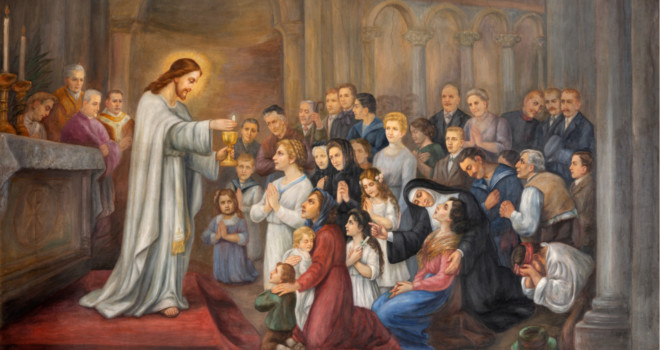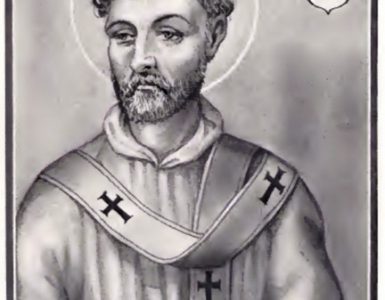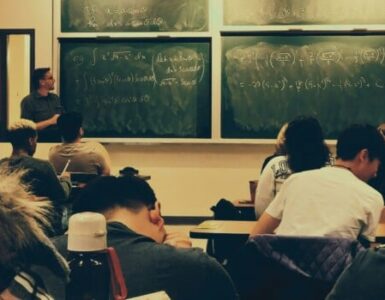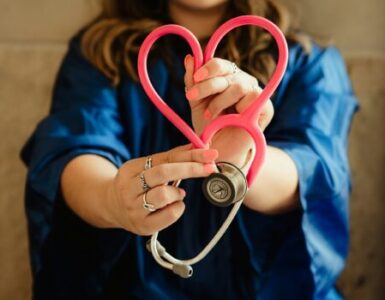Soon, we will return liturgically to the relative “quiet” of Ordinary Time, after so many celebrations of great historical events in Jesus’ life. Today, we pause to look back at the Last Supper. Why?
Gospel (Read Mk 14:12-16, 22-26)
Now that we have liturgically re-lived with Jesus the culmination of His earthly ministry and His return to Heaven, it might seem that Jesus has, in a sense, gone away. The celebration of Christ the King and His triumphant return to the world He died to save is many months away. To avoid thinking that the long period of Ordinary Time is a time of Jesus’ “absence,” the Church calls us to the observance of the Body and Blood of Christ, or Corpus Christi. Our Gospel takes us back to the institution of the Eucharist, lest we forget that although Jesus reigns now over His Church from His throne at God’s right hand, He has given us the extraordinary gift of His continuing Presence in the bread and wine at Mass. In a way, liturgically speaking, we are better able to truly understand this gift than when we remembered it during Holy Week. Why?
During Holy Week, our meditation of the Last Supper was an anticipation of something that lay ahead. Jesus offered the death He was about to undergo as an offering for sin. He knew that He would receive His life back again, conquering death, so He was able offer the apostles, mysteriously, that indestructible, glorified life in the bread and wine He gave to them. It took Easter and the Ascension for us to fully comprehend that when Jesus rose from death, He entered a new mode of human existence. In His post-Resurrection appearances, He did some things humans can do (eat, talk, be touched), as well as some things human can’t do (appear and disappear, be unrecognizable to His best friends, yet known to them). The Ascension took Jesus permanently away into that invisible mode of human existence, but, because His human Body is able to do things ours can’t, He can still be present to us in an unrecognizable but known way—in the Eucharist. No wonder the Church wants to remind us of this now!
Jesus’ gift of Himself to us in the Eucharist, as the centerpiece of His Church’s worship, breaks through the barriers of time and space to anchor us in mystery. For Catholics, the life of Jesus was not simply linear. That is, He did not simply accomplish a cluster of magnificent historical events and then disappear until His return. He did not simply send His Spirit into the world to take His place in the hearts of men and the life of the Church—as wonderful as all that is, of course. No, in addition to the life He lived and the Spirit He imparted, He grants us the same mysterious communion with His Body and Blood that His apostles first experienced at the Last Supper. Present on all the altars of the world, He has not left us orphans. The Body and Blood of Jesus (so human, so real) that saved us on the Cross and then rose to Heaven remains within time and space to be ever present for the salvation of the whole world, in all times and places. This is the gift that will enable us to persevere until the end of time. It is the abiding and irrefutable proof that God loves us, flesh and blood. Because of it, although we will soon resume Ordinary Time, nothing can ever be “ordinary” again.
Possible response: Lord Jesus, I know that I long to be close to You. Your gift of the Eucharist shows me how You long to be close to me, too. Please help me remember this.
First Reading (Read Ex 24:3-8)
Here we see one of the most important Old Testament events in Israel’s life, and it is crucial to our understanding of the Last Supper. When Moses had delivered God’s people from bondage, he took them to Mt. Sinai to meet their God. Prior to this, they had only known Him through the stories passed on in their oral tradition, which would have included Creation, the Flood, and the lives of the patriarchs. Of course, the incredible signs and wonders Moses worked in Egypt to free them from slavery taught them quite a bit, too. However, when they got to Sinai, God not only came down in a visible way (in terrifying pyrotechnics), but He also gave them a code of conduct (the Ten Commandments) and a way to worship Him (the Tabernacle). They were truly a real nation—a priestly nation—now. Before ratifying this covenant, God gave them a choice (as He always does with all men). Moses read the terms of the covenant to the people, then waited for their response. In essence, they said, “Sign us up!” That is when the blood from the animal sacrifice that was to be offered on the altar was splashed on the people as well. The blood sealed them into kinship with God, Who was represented by the altar. When the people looked at the blood on their own bodies, they knew that a remarkable relationship had now been established with God. It was an event never to be repeated in Israel’s long, tumultuous history.
Flash forward to the Last Supper. If we wonder why Jesus wants to give His followers His Body and Blood to take into their own bodies, we can see that he was drawing on the Jewish belief that sharing blood in covenant-making creates kinship. The Body and Blood of our Savior mingles with our own; we are one people with Him.
The people at Sinai who had altar blood on them knew something extraordinary was taking place. When we receive from our altars the Most Holy Body and Blood of Jesus, so should we.
Possible response: Lord Jesus, thank You for spilling blood so that I could share kinship with You.
Psalm (Read Ps 116:12-13, 15-18)
The best way to read this psalm is to imagine we can hear Jesus reading it, because truly it is His prophetic Voice written hundreds of years before He lived. On Jesus’ lips, this psalm is a prayer of praise and thanksgiving for God’s faithfulness to Him, especially in deliverance from death. This was a psalm recited in the Jewish celebration of Passover. Surely Jesus recited it at the Last Supper. He took up “the cup of salvation,” which would mean death for Him. However, He knew that “precious in the eyes of the Lord is the death of his faithful ones.” He knew Himself to be “the son of [God’s] handmaid [Mary]”; He knew that death would not hold Him (“You have loosed My bonds”).
Now, in the Eucharist, Jesus offers His followers the same joy expressed in the psalm. The Eucharist is our “sacrifice of thanksgiving.” As we offer and receive it, we can sing our responsorial with confidence: “I will take the cup of salvation, and call on the name of the Lord.”
Possible response: The psalm is, itself, a response to our other readings. Read it again prayerfully to make it your own.
Second Reading (Read Heb 9:11-15)
The epistle gives us a rare glimpse behind the veil of invisibility that covered Jesus when he ascended to the Father in heaven. It draws back the curtain so we can have an image of what Jesus did when He left us. He fulfilled His work as High Priest on our behalf, entering the “sanctuary” of heaven with the perfect, final offering for sin—Himself, taking “His own blood.” He is there now as our “Mediator of a new covenant.” Each time we receive His Body and Blood from the altar at Mass, we share His exalted life and receive into our own bodies a guarantee of the “promised eternal inheritance,” the fruit of the Eucharistic meal. Our consciences are cleansed “from dead works to worship the living God.”
The Lauda Sion (Laud, O Zion) sequence, often part of the Corpus Christi liturgy, describes this beautifully:
Now the new the old effaces,
Truth away the shadow chases.
Light dispels the gloom of night.
What He did at supper seated,
Christ ordained to be repeated,
His memorial ne’er to cease:
And His rule for guidance taking,
Bread and wine we hallow, making
Thus our sacrifice of peace.
Possible response: Lord Jesus, I only barely comprehend how You have joined heaven and earth in Your Body and in mine. Help me ponder this mystery on this special day.
✠
image: Symbolic fresco Jesus give the communion in church Pfarrkirche Kaisermühlen (Vienna) by Renata Sedmakova / Shutterstock.com












